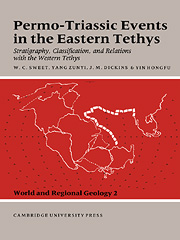 Permo-Triassic Events in the Eastern Tethys
Permo-Triassic Events in the Eastern Tethys Book contents
- Frontmatter
- Contents
- List of contributors
- Preface
- Acknowledgments
- 1 Permo-Triassic events in the eastern Tethys – an overview
- 2 Permo-Triassic boundary relations in South China
- 3 Permo-Triassic boundary of the Indian subcontinent and its intercontinental correlation
- 4 Permo-Triassic boundary on the Indian peninsula
- 5 The Permo-Triassic boundary in the southern and eastern USSR and its international correlation
- 6 Classification and correlation of nonmarine Permo-Triassic boundary in China
- 7 Permian and Triassic events in the continental domains of Mediterranean Europe
- 8 The Permo-Triassic boundary in the Southern Alps (Italy) and in adjacent Periadratic regions
- 9 Permo-Triassic brachiopod successions and events in South China
- 10 Conodont sequences in the Upper Permian and Lower Triassic of South China and the nature of conodont faunal changes at the systemic boundary
- 11 A conodont-based high-resolution biostratigraphy for the Permo-Triassic boundary interval
- 12 The palynofloral succession and palynological events in the Permo-Triassic boundary interval in Israel
- 13 The effects of volcanism on the Permo-Triassic mass extinction in South China
- 14 Geochemical constraints on the Permo-Triassic boundary event in South China
- 15 Permo-Triassic orogenic, paleoclimatic, and eustatic events and their implications for biotic alteration
- 16 Permo-Triassic boundary in Australia and New Zealand
- Index
1 - Permo-Triassic events in the eastern Tethys – an overview
Published online by Cambridge University Press: 12 October 2009
- Frontmatter
- Contents
- List of contributors
- Preface
- Acknowledgments
- 1 Permo-Triassic events in the eastern Tethys – an overview
- 2 Permo-Triassic boundary relations in South China
- 3 Permo-Triassic boundary of the Indian subcontinent and its intercontinental correlation
- 4 Permo-Triassic boundary on the Indian peninsula
- 5 The Permo-Triassic boundary in the southern and eastern USSR and its international correlation
- 6 Classification and correlation of nonmarine Permo-Triassic boundary in China
- 7 Permian and Triassic events in the continental domains of Mediterranean Europe
- 8 The Permo-Triassic boundary in the Southern Alps (Italy) and in adjacent Periadratic regions
- 9 Permo-Triassic brachiopod successions and events in South China
- 10 Conodont sequences in the Upper Permian and Lower Triassic of South China and the nature of conodont faunal changes at the systemic boundary
- 11 A conodont-based high-resolution biostratigraphy for the Permo-Triassic boundary interval
- 12 The palynofloral succession and palynological events in the Permo-Triassic boundary interval in Israel
- 13 The effects of volcanism on the Permo-Triassic mass extinction in South China
- 14 Geochemical constraints on the Permo-Triassic boundary event in South China
- 15 Permo-Triassic orogenic, paleoclimatic, and eustatic events and their implications for biotic alteration
- 16 Permo-Triassic boundary in Australia and New Zealand
- Index
Summary
Introduction
It has long been clear that waning stages of the Permian Period and initial phases of the Triassic make up an interval of time during which there were profound changes in the Earth's internal and surficial features, in its atmosphere and climate, and, conspicuously, in its biota. Unfortunately, however, rocks that record this fascinating segment of Earth history are greatly restricted in distribution by comparison with those from which we reconstruct events in earlier Paleozoic or later Mesozoic history. Furthermore, subsequent orogenic cycles have dismembered, effaced, and in other ways complicated the record. In combination, these factors make development of a stratigraphic scale for the Permo-Triassic boundary interval difficult, and this, in turn, serves to insure that the history of the latest Permian and earliest Triassic has been reconstructed thus far in only very general outline.
Project of 203 of the International Geological Correlation Programme (IGCP) was organized in 1984 with the aim of integrating modern studies of rocks and fossils in the Permo-Triassic boundary interval into an internally coherent and well-controlled body of information from which it might ultimately be possible to infer something meaningful about the history of late Paleozoic and early Mesozoic times. The attention of project participants naturally focused on Permian and Triassic strata in the eastern part of the Tethyan realm, in South China and India, for marine rock sequences of this age are most continuously developed there. However, close cooperation with students of the Permian and Triassic in Italy, Hungary, Yugoslavia, Israel, the Soviet Union, Australia, and New Zealand has enabled development of a data base that now includes information for essentially the entire length and breadth of the former Tethys seaway.
Information
- Type
- Chapter
- Information
- Permo-Triassic Events in the Eastern TethysStratigraphy Classification and Relations with the Western Tethys, pp. 1 - 8Publisher: Cambridge University PressPrint publication year: 1992
Accessibility standard: Unknown
- 6
- Cited by